Thinking about giving your bathroom a fresh new look? Whether you’re dreaming of a simple refresh or a full bathroom remodel, understanding the cost involved is a crucial first step. Bathroom renovation cost can vary widely depending on the size of the space, the quality of materials you choose, and whether you’re handling parts of the job yourself or hiring professionals.
This guide breaks down what you can expect to spend and where your money actually goes from tiles and fixtures to labor and permits. Whether you’re updating a powder room or planning a full shower renovation, we’ll help you plan smarter and avoid surprises. Let’s dive in and make your renovation project as smooth and affordable as possible.
Table of Contents
Bathroom Renovation Cost Breakdown: Materials, Labor, and Fixtures
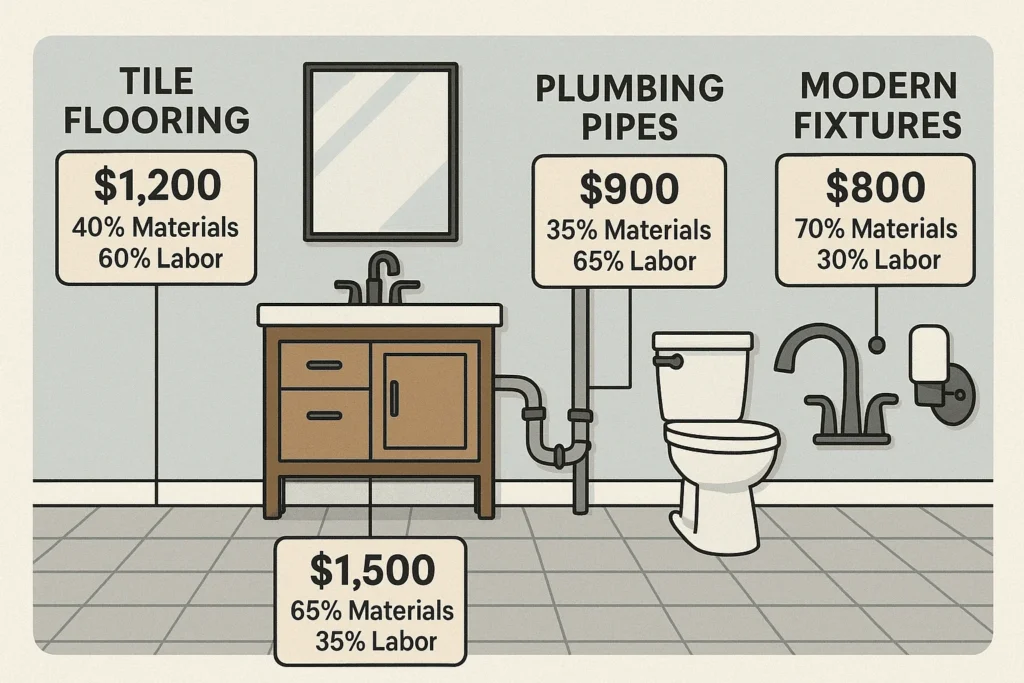
When you dive into a bathroom remodel, it helps to see exactly where your money goes. Breaking down your bathroom renovation cost into three main buckets materials, labor, and fixtures lets you make smart choices without surprises.
Materials: Tile Flooring, Vanity, Plumbing, Fixtures
- Tile Flooring: Porcelain or ceramic tile typically runs $2–$10 per square foot. If you’re doing a shower renovation, waterproof wall tile can add a few dollars more, but it’ll protect against leaks down the road.
- Vanity: Stock vanities start around $150, while custom wood or stone-topped units can reach $1,500. Think about how often you upgrade sometimes a durable, mid-range vanity is the best value.
- Plumbing Supplies: Pipes, valves, and connectors usually total $200–$500. If you’re moving fixtures (for example, shifting the toilet or sink location), expect extra piping costs.
- Fixtures (Faucets, Showerheads, Lighting): A good-quality faucet may cost $80–$300. For a full shower renovation, budget $300–$600 for a rain-style head, plus any hand sprayers or body jets.
Material Costs vs. Labor Costs
On average, materials make up about 40–50% of your bathroom renovation cost, with labor filling the rest. Labor rates vary wildly $50–$100 per hour is typical but remember that pros often bundle demo, tiling, plumbing, and electrical into package prices.
Actionable Tip: Get at least three itemized quotes. Seeing “tile installation” broken out separately helps you negotiate maybe you supply the tile and only pay for the install.
The Role of a Licensed Contractor
Hiring a licensed contractor might feel like a splurge, but it’s an insurance policy against mistakes. A pro will:
- Ensure code compliance: Proper venting, waterproofing, and electrical work keep your remodel safe and legal.
- Manage subcontractors: Coordinating the plumber, electrician, and tiler takes work let the contractor handle scheduling and quality checks.
- Protect your investment: Most licensed contractors carry liability insurance, so any on-site accidents won’t come out of your pocket.
By understanding these three pillars’ materials, labor, and fixtures you’ll keep your bathroom remodel on budget and avoid those late-night “oops” moments when an unplanned expense pops up.
More Renovations:
Average Bathroom Renovation Cost by Project Type
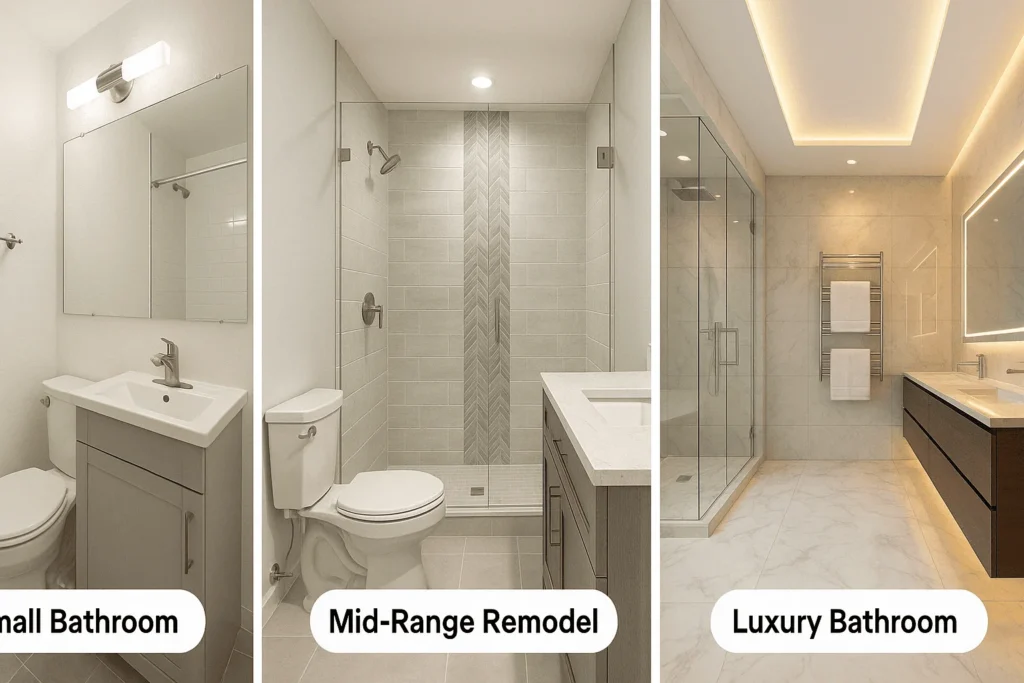
Every bathroom remodel starts with an honest look at your space and budget. Here’s a realistic snapshot of what you can expect to pay so you can plan without sticker shock.
Small Bathroom Renovation Cost
- Scope & Range: Think cosmetic updates like fresh paint, new fixtures, and a basic shower renovation. Expect to invest $5,000–$10,000 for a 25–40 sq ft powder room or guest bath.
- What You Get: A new vanity, upgraded faucet, refaced cabinets, and a tile-toceiling shower surround. No plumbing moves keeps labor costs lower.
- Actionable Advice: Swap in a prefabricated shower pan rather than re-tiling the floor this can save you $1,000 or more while still refreshing the space.
Mid‑Range Remodel
- Scope & Range: For a primary bathroom that serves your family daily, mid‑range projects run $15,000–$25,000. This covers custom tile, a glass shower enclosure upgrade, and repositioning fixtures if needed.
- What You Get: Stylish stone or subway tile, a frameless shower door, a solid-surface vanity countertop, and a modern toilet. You’ll also factor in about $3,000–$6,000 specifically for shower renovation pieces (glass, tile, plumbing).
- Actionable Advice: Prioritize durability choose water‑resistant backer board behind tile and a quality membrane under the floor to avoid costly water damage down the line.
Luxury Bathroom Upgrade
- Scope & Range: High‑end finishes, custom millwork, and spa‑style features push the bathroom renovation cost to $30,000–$50,000+. Think heated floors, steam showers, dual vanities, and designer fixtures.
- What You Get: Premium materials like marble tile, a built‑in steam unit in the shower renovation, custom cabinetry, and smart lighting controls. Labor often accounts for 50%–60% of this budget because of the complexity.
- Actionable Advice: Get a detailed line‑item quote. When you’re spending over $30K, understanding exactly where each dollar goes (tile by square foot, labor hours, niche installation) keeps the project transparent and you in control.
Putting It All Together
- Average Figures: According to NKBA benchmarks, the U.S. average bathroom remodel sits around $24,000 right in that mid‑range sweet spot.
- Regional Variations: Costs in major metro areas (think New York or San Francisco) can run 20%–30% higher than the national average.
- Final Tip: Match your goals to your budget. If resale value matters most, mid‑range upgrades typically recoup more of your bathroom renovation cost than ultra‑luxury splurges. Choose the project type that aligns with your lifestyle, timeline, and long‑term plans to ensure a remodel you love and can afford.
DIY Renovation vs Hiring a Licensed Contractor

Deciding between tackling a bathroom remodel yourself or calling in a pro comes down to three big questions: budget, skill level, and peace of mind.
When DIY Makes Sense
- Lower labor costs: Skipping contractor fees can shave thousands off your bathroom renovation cost great if you’re only swapping out a vanity, painting walls, or installing new lighting.
- Hands‑on control: You choose every detail, from grout color to towel bar placement. If you love weekend projects and have basic carpentry or plumbing know‑how, DIY can be rewarding.
- Time investment: Remember, you’re juggling demo, prep, and cleanup on nights and weekends. That midweek shower renovation might stretch over several weekends if you’re fitting it in around work.
When to Hire a Licensed Contractor
- Complex plumbing or electrical work: Moving drains or rewiring for new lighting almost always requires permits and code compliance. A pro will handle inspections and keep your remodel legal.
- Warranty and liability: Licensed contractors carry insurance if something goes wrong (say a leak behind that new shower tile), you won’t be left footing a surprise bill.
- Efficient timeline: Pros coordinate subcontractors (plumber, electrician, tile setter) like an orchestra, often finishing in a fraction of the time it would take an individual.
Actionable Tip:
If you’re itching to save on labor, consider a hybrid approach: hire a pro for plumbing and shower renovation, then tackle painting, hardware installation, and decorative trim yourself. This keeps your bathroom renovation cost in check while ensuring critical work meets professional standards.
Financing Options and Budgeting Strategies

Figuring out how to pay for your bathroom remodel can feel almost as daunting as picking tile. Here’s a straightforward way to tackle financing and keep your numbers in check.
First, explore your funding choices. If you have built‑in equity, a home equity loan or HELOC usually offers the lowest interest rates, but it can take a few weeks to finalize. For quicker cash, a personal loan or a 0% APR credit card might cover a smaller shower renovation or fixture swap just be sure you understand what the rate jumps to after the introductory period. Some homeowners streamline everything by doing a cash‑out refinance, combining mortgage and renovation debt into one payment. And if you’re lucky enough to tap savings or a rainy‑day fund, paying out of pocket eliminates loan fees altogether.
Once you know where the money is coming from, break your total bathroom renovation cost into clear categories: tile and flooring, plumbing materials, fixtures (think faucets and showerheads), permits, labor, and a 10–15% cushion for the unexpected. Seeing “shower renovation” supplies next to permit fees on a single spreadsheet keeps you honest so when a quote for glass doors comes in higher than planned, you can decide to swap in a more budget‑friendly model or reallocate funds from another line item.
Actionable tip: set up a simple tracker whether it’s a Google Sheet or an app like YNAB to log every expense as soon as it hits your account. Review it weekly against your original estimates. Catching a cost overrun early means you can adjust before it pushes your project past your budget. By choosing the right loan and keeping a disciplined budget, you’ll enjoy your updated bathroom without dreading the final b
Permits, Inspections, and Regulatory Fees
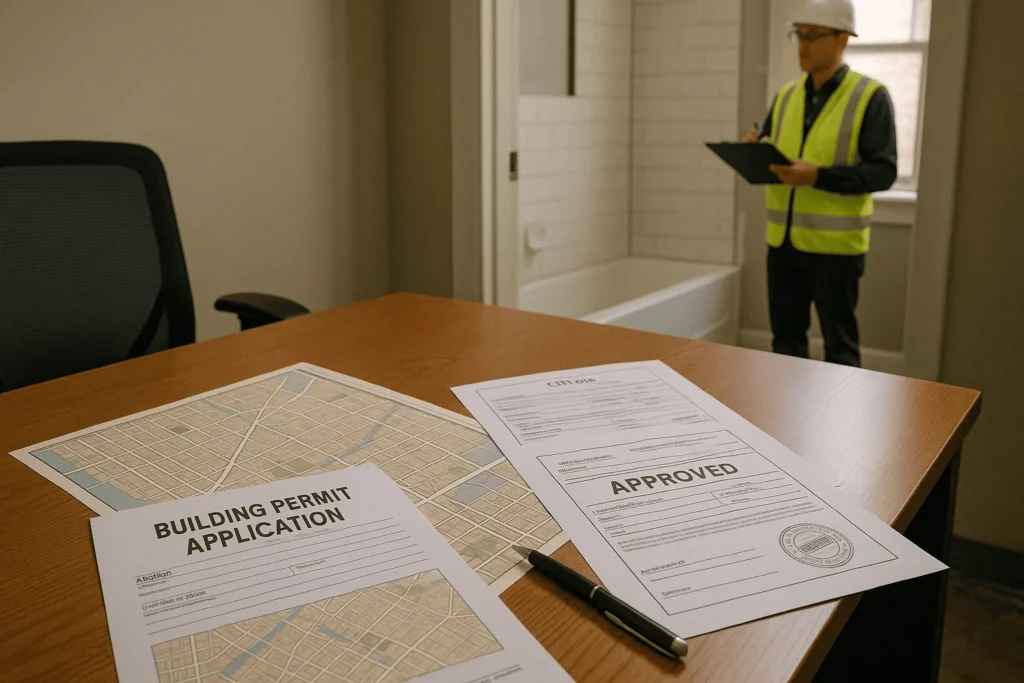
It’s easy to get caught up in picking tiles and vanities, but before you swing that first hammer, make sure your project’s on the right side of the law. Permits and inspections might not be the most exciting part of a bathroom remodel, but skipping them can lead to fines, delays, or costly redos.
When Permits Are Required
Simple cosmetic updates like painting walls or replacing a faucet usually don’t require permits. But once you move plumbing, add electrical wiring, or change the room’s structure, you’ll likely need one. Even something that feels small, like a shower renovation that includes moving drains or installing a new exhaust fan, can trigger the need for inspection.
Who Handles the Paperwork
If you’re working with a licensed contractor, they’ll often handle the permit process and coordinate inspections. That’s one of the perks of hiring a pro they know your local codes and what’s required. If you’re going DIY, it’s on you to check with your city or county’s building department. They’ll tell you what’s needed, what the fees are, and how long it’ll take to get approval.
The Cost of Compliance
Permit costs vary depending on location and project scope. Expect to spend anywhere from $100 to $1,000. Some areas charge flat fees, while others calculate them based on your total bathroom renovation cost. And don’t forget inspections these are often scheduled at key stages (like after plumbing is roughed in or tile is installed) to ensure everything’s up to code.
Why It’s Worth It
Following permit rules protects your investment. If you ever sell your home, unpermitted work can complicate the process or scare buyers off. Plus, if something goes wrong (like a leak behind a tiled shower wall), insurance may not cover the damage if it wasn’t inspected.
Bottom line? Don’t skip this step. It might take a little extra time and money upfront, but it could save you a huge headache down the road.
Return on Investment and Impact on Real Estate Value
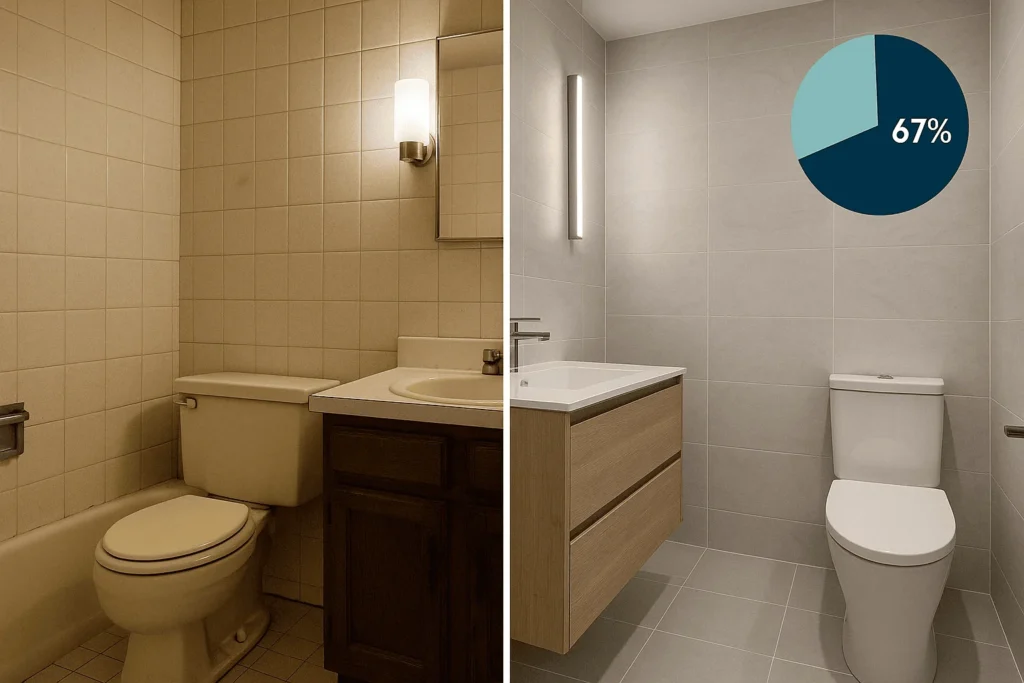
A bathroom remodel isn’t just about making your space more comfortable it can also be a smart financial move. Whether you’re planning to sell soon or just want to boost your home’s overall value, updating your bathroom is one of the most impactful renovations you can make.
How Much Value Can You Expect to Add?
On average, a mid-range bathroom renovation recoups around 60–70% of its cost when you sell your home. High-end remodels can bring in less proportionally, but they may still increase buyer appeal in competitive markets. The exact return depends on your location, the quality of the work, and the features you include. A sleek walk-in shower renovation, double vanity, or modern tile work can all catch a potential buyer’s eye.
What Buyers Look For
Homebuyers love bathrooms that feel clean, functional, and modern. Think updated lighting, efficient layouts, neutral tones, and energy-saving fixtures. Even if you’re not planning to sell immediately, making smart upgrades now ensures you’ll get more out of your investment when the time comes.
Small Updates That Pay Off
You don’t need to gut the entire room to see a return. Replacing outdated fixtures, refreshing tile, or upgrading a vanity can make a big visual impact without blowing your budget. These small touches can still raise your home’s perceived value and improve day-to-day comfort.
Actionable Tip:
If resale is part of your long-term plan, keep your design choices classic and timeless. Avoid overly bold or trendy styles that could turn off future buyers. Instead, aim for a clean, versatile look that will stand the test of time and deliver the best return on your bathroom renovation cost.
Project Timeline and Phases
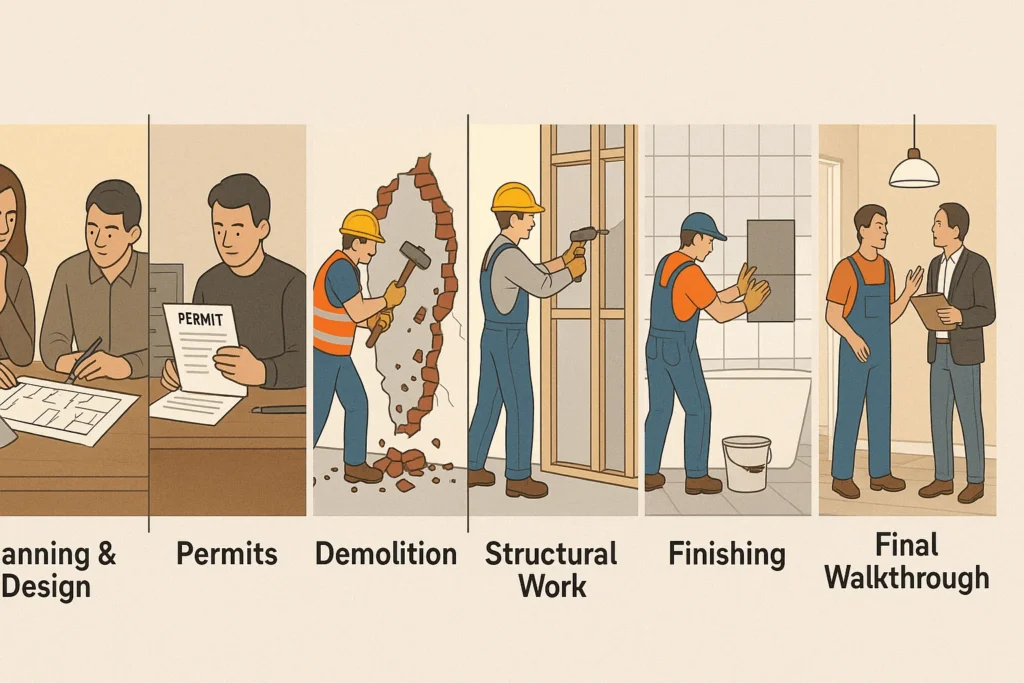
Understanding the typical timeline for a bathroom remodel can help you plan better, reduce stress, and avoid surprises. While every project is a little different, most renovations follow a similar path from the first sketch to the final clean-up.
1. Planning and Design (1–3 weeks)
This is where your vision takes shape. You’ll research styles, choose materials, and get quotes from contractors. If you’re doing a more involved shower renovation or rearranging the layout, this stage might also include working with a designer or architect. Take your time here it lays the foundation for everything that follows.
2. Permits and Approvals (1–2 weeks)
If your remodel involves electrical, plumbing, or structural changes, you’ll likely need a permit. Your contractor may handle this, but if you’re going the DIY route, plan to visit your local building office. Waiting on approvals can slow things down, so it’s smart to factor this into your schedule early.
3. Demolition (2–4 days)
Time to tear out the old to make room for the new. Demolition is usually quick, but you might uncover hidden issues like mold, old wiring, or plumbing problems that need to be addressed before moving on. These surprises can impact your timeline and your bathroom renovation cost.
4. Structural and Systems Work (1–2 weeks)
This phase includes framing, plumbing, electrical, and HVAC updates. It’s when the “behind-the-walls” work happens. If you’re relocating your shower or adding outlets, it’ll happen here. Afterward, inspections may be required before moving to the next stage.
5. Installation and Finishing (2–3 weeks)
Now the space starts to come together. Drywall goes up, tiles are laid, vanities are installed, and your fixtures like faucets, lights, and that dreamy new showerhead are connected. Painting and finishing touches wrap it all up.
6. Final Walkthrough and Clean-Up (1–2 days)
You’ll inspect the work with your contractor, check for any missed details, and ensure everything functions properly. Make a punch list of small fixes if needed. Once it’s all complete, enjoy your updated space!
Tips to Reduce Your Bathroom Renovation Cost
A bathroom remodel doesn’t have to drain your savings. With a little planning and smart decision-making, you can create a beautiful space without blowing your budget. Here are some practical ways to keep your bathroom renovation cost under control while still getting the look and function you want.
Keep the Layout the Same
Moving plumbing lines for sinks, toilets, or showers can get expensive fast. If your current layout works, keep it. Sticking with the existing setup cuts down on labor and material costs, especially when it comes to shower renovation and drainage systems.
Refinish Instead of Replacing
Before you rip out that tub or toss the vanity, consider refinishing it. Reglazing a bathtub or repainting cabinets can refresh the look for a fraction of the cost of new ones. You get a clean, modern feel without the hefty price tag.
Shop Smart for Materials
You don’t need high-end finishes to get a high-end look. Check out clearance sections, outlet stores, or even gently used fixtures. Swapping pricey tiles for budget-friendly alternatives like large-format porcelain can still look sleek and stylish while saving money.
Do Some Work Yourself
Even if you’re hiring a contractor for the big stuff, there are tasks you can tackle yourself. Demolition, painting, or installing accessories like towel bars and mirrors are all doable with a little research. Every bit of DIY work can chip away at labor costs.
Plan Ahead and Stick to It
Changing your mind halfway through the project is one of the biggest budget busters. Finalize your design, materials, and layout before you begin and stick to the plan. This avoids delays, extra charges, and last-minute stress.
Reuse What You Can
If your existing mirror, light fixture, or shelving still works, work it into the new design. Sometimes a good clean or a fresh coat of paint is all it takes to make old items feel new again.
Actionable Tip:
Set a realistic budget, but leave 10–15% wiggle room for unexpected costs. That way, if something comes up mid-renovation (and it usually does), you won’t be caught off guard.
Smart choices now can help you create a refreshed bathroom you love without overspending.
FAQs
What’s the cheapest way to remodel a bathroom?
The most budget-friendly approach is to focus on cosmetic updates. Think paint, new hardware, or updated lighting. Reuse what you can like your vanity or mirror and shop smart by checking outlet stores or online marketplaces. Avoid moving plumbing, and tackle simple DIY projects like painting or installing shelves to save on labor.
How much should I budget for unexpected costs?
A good rule of thumb is to set aside an extra 10% to 20% of your total renovation budget for surprises. This cushion covers things like hidden water damage, outdated wiring, or price changes in materials. Having that buffer helps you avoid stress and keeps your project on track.
Do I need to hire a plumber for a simple fixture swap?
If you’re just replacing a faucet or showerhead and the plumbing connections stay the same, you might be able to do it yourself with a bit of research and the right tools. But if you’re unsure, or if anything involves pipes behind walls, it’s wise to call a licensed plumber to avoid leaks or costly mistakes down the line.
How long does a bathroom renovation take?
The duration of a bathroom remodel typically ranges from 3 to 8 weeks, depending on the project’s complexity and scope of work.
What is the difference between a partial and full bathroom remodel?
A partial remodel typically involves updating specific elements, such as replacing a vanity or fixtures. A full remodel encompasses a comprehensive overhaul, including changes to layout, plumbing, electrical systems, and all surfaces and fixtures.
